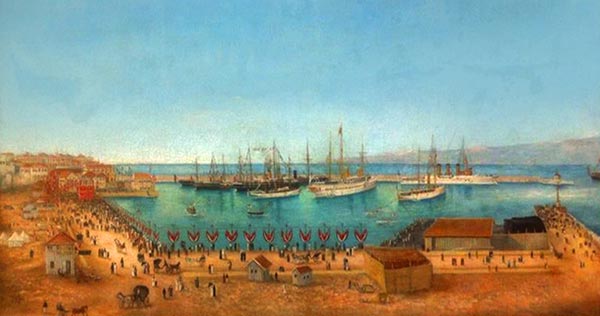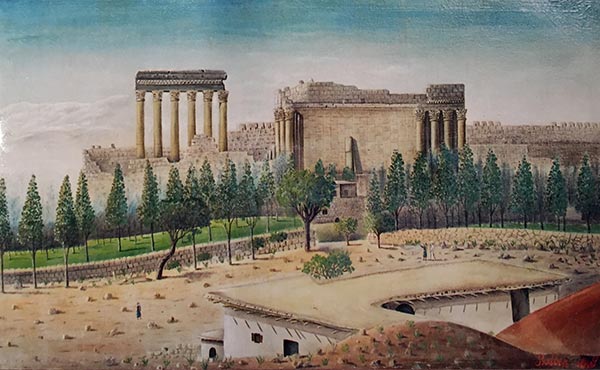Artist-painter Ibrahim Serbai
Ibrahim Serbai was born in 1865 in Ain-Mreisseh, a coastal neighborhood of Beirut. He did his early studies in the city colleges and later studied painting at the “Ottoman Sultanate school” of Bashoura. He died in 1931.
Beginnings & origins
Being born in a conservative Sunni family, he was naturally influenced by the orientalist painters, the Ottoman and Persian miniatures, but mostly by the topographic precision of the Turkish Officers-Engineers or the Ottoman Army who came to Beirut.
Serbai painted sites, landscapes, the sea and the portraits of some rich dignitaries from the city.
Together with similar and likeminded artists, he was to belong to “the Marine School of Beirut”, much as, or following the example of “the Ottoman Marine School”. The Beirut school was composed of a plethora of local self-taught painters, having lived and studied painting in Beirut and Istanbul.
Next to Serbai, there were Hassan Tannir, Ali Jammal, Dimashkieh, Toufic Tarek, Mohamad Said Merhi, NajibBekhazi and Salim Haddad who all left their mark on our national art for a half century, from late 19th to early 20th centuries.
Michel Fani, in his dictionary of the Lebanese Painting, reckons Mostafa Farroukh and Salah Lababidi as the lasting echo of this school of art.
A serenely detailed art
The “Marine School of Beirut” was also called, by some, the “Sunni School of Beirut” for the majority of its members were Sunni Muslims from Beirut.
These artists, but mainly Serbai as a leading figure, won renowned for their pictorial, figurative, serene, captivating but meticulous, painstakingly detailed paintings. These were sort of emulation to the military maps and photos in their rigorous attentiveness to details, making them works with a sense of reality, thus rivaling the art of photography.
The colors are sober, neither garish nor vivid, with nothing striking but rather real, drawn from the model itself. The “Chioroscuro” technique brought on an added charm, refinement and harmony to the oriental taste and smoothness. Which made Farroukh, in his famous 1947 conference to the “CénacleLibanais”, declare the painting done by Serbai reminded him of Canaletto’s.
Historical events
Some painters of the “Marine School” were socially and politically implicated, therefore they commemorated historical events of their era. Serbai was particularly interested in the Temples of Baalbeck’s first renovation, so much so that he had already painted the site circa 1895-96 prior to the renovation (Balbek-oil on canvas 90x150cm). later, he painted, in 1898, the historical visit of the German Emperor Wilhelm II to Beirut Seaport after the Emperor’s pilgrimage to Jerusalem.
Upon his return to Germany, the Emperor dispatched a delegation to Lebanon charged with the mission to restore the Temples that have been neglected for centuries.
The painting commemorating the Emperor’s visit was such a success that Serbai had to make several copies in order to satisfy his clients (oil on canvas 74x135cm).
Posthumous attributions
Michel Fani, in his dictionary, attributes to Serbai an unsigned (oil on canvas70x200cm) depicting a panoramic view of Ras Beirut. It was told that this painting was hanging for over 50 years in the lobby of the famous “Hôtel d’Orient”, later renamed “Bassoul”, in Zeitouni quarter.
Two more attributions to Serbai were made by Dr. Maha Azizeh Sultan in her book “the pioneers of plastic art in Lebanon - Corm, Srour, Salibi 1870-1938"(Ed.Kaslik-2006). One is a panoramic view of Beirut featuring the Pine forest(Al-Horsh). The other commemorates the passing of two newly acquired Ottoman destroyers along the Beirut coast.
Neglect and under-valuation
Sadly, the “Marine School” is very rarely documented and badly inventoried, more so that its members were not really prolific artists. Many of their works disappeared, probably due to a number of reasons: the quality of the used materials, the bad weather conditions, the ignorance of conservation means but mainly, and most aggravating, the work of those artists was not duly valued by the owners along the years.
For more infos about Serbai and his fellows of the “Marine School”, please visit the site: www.ibrahim-serbai.com.

Reception of Guillaume II at the Port of Beirut, Oil on canvas 134x74 cm (Painting of the Port of Beirut)

Baalbeck, Oil on canvas 150x90cm (Eddy Sfeir Collection)